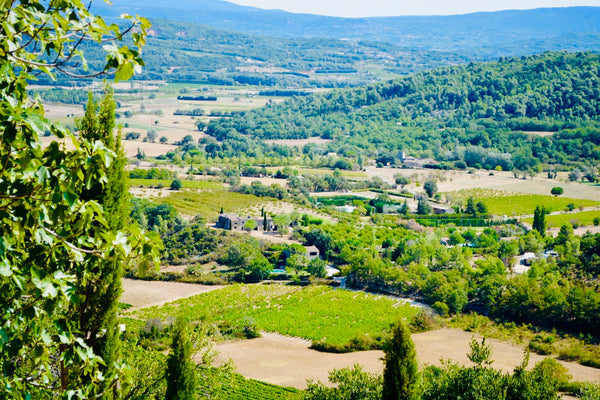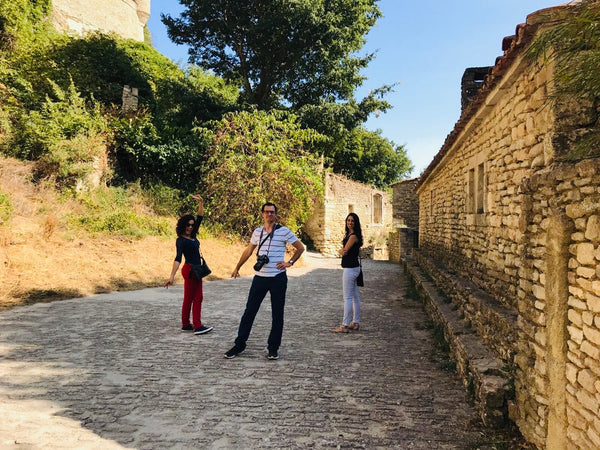A Walk Through Gordes, Provence’s Crème de la Crème
I remember Tombstone. And Bisbee. Two scenic Arizona towns where one would want—and expect—to find the kind of things featured in authentic, old-school Spaghetti Westerns: a wide, dusty Main Street lined with saloons where cowboys, fur trappers and notorious outlaws caroused until the wee hours, dodgy gambling parlors, mine shafts, sawmills and abandoned scrapyards… In short, a time capsule that seems to have traveled through the ages.
Gordes is to an American what Tombstone or Bisbee are to a French: a picture-perfect postcard that goes above and beyond one’s expectations.
Crowned “the jewel of Provence,” Gordes is the embodiment, the ‘crème de la crème’ of all French Provençal villages. With Roussillon, Ménerbes, Venasque, Séguret, Lourmarin, and Ansouis, Gordes belongs to an exclusive circle of seven villages named les plus beaux villages de France (“France’s most beautiful villages”) in the Provence Department of Vaucluse. Nested in a spectacular setting, the quaint yet glamorous village of Gordes lives up to its reputation.

From Local Oppidum to International Stardom
“Why in the world did they build that up there?” you wonder, while gazing at the castle perched atop the mountain bluff. From the famous rocher Bel Air (a natural, scenic rock platform on the side of the road leading up to the village), your first impression of Gordes is one of sheer astonishment.
As you stare at the terracotta-tiled houses hanging from the cliffs, spiraling around like a lush crème chantilly on a café viennois, you can’t help but ponder: “Why would anyone strive to build such an intricate architectural maze?” The answer is quite simple: survival.
Gordes’ history dates back to the first century BCE and spreads over two millennia. At the time, the “French” were… Celts. And while the Parisii Celtic tribe had settled on the banks of the Seine river (hence the name of France’s modern-day capital), another Gallic tribe, the Vordenses, threatened by Julius Caesar’s armies, was leaving the Calavon river valley to build its oppidum (fortified settlement) up high, on a rocky promontory. Defeated by Caesar, the Vordenses tribe later lent its name to the Roman colony, which became Gordense, then Gordae… and eventually Gordes.
During the turbulent times of the Middle Ages, the village kept growing, becoming a true citadel with massive fortifications to protect itself from assailants. An impressive château (castle) with clear, panoramic views of the valley was built in the 11th century.
Laure, whose ancestors worked as shoemakers in the village in the 1600s, is now the proud keeper of the castle. She shares a fun fact about the premises: “Actually, the castle was never inhabited! It’s something very specific to this site. The lords would never come to Gordes because it was just too isolated and hard to reach. The fortress has been used as a prison and a warehouse for storing harvests and to house garrisons.”
In the mid-1940s, Gordes is nothing but a forgotten village in the heart of la Provence. However, thanks to its remote location and despite World War II ravages, much of its charm is left intact. At first deserted or neglected, it won’t take long for world-renowned artists such as painters Marc Chagall and Victor Vasarely or photographer Willy Ronis to search for inspiration at its bedside, before falling in love with its old stones—a prelude to its newfound glory.
Today, about half a million visitors come to Gordes each year to soak in its beautiful sceneries, authentic feel, and peculiar atmosphere.

A Village Nested in Lush Greenery
Gordes’ limestone bluff is located on a gorgeous mountain range (the Monts du Vaucluse), and faces, across the valley, yet another spectacular geological wonder: the mountains of the Luberon.
From the roof of the castle, the view at dawn is simply mesmerizing. As far as the eye can see, a hazy patchwork of olive groves, vineyards, and almond trees, each competing to grab your attention. In between the rolling hills, small hamlets punctuate the landscape, while slender cypresses proudly rise among the orange tiles and purple shutters of ritzy villas.
The greens and yellows of the alluvial plain offer a stark contrast with the bluish greys of the breathtaking massif du Luberon. Its rocks and rugged terrain give way to smaller native shrubs, Provence’s garrigue. Aromatic plants such as lavender, sage, rosemary, and wild thyme give off a rich and vibrant bouquet detected from miles away.
Speaking of this region of France, David Tatin, a photographer who fell in love with Gordes, opens up: “This region allows for an infinite array of photographs. Forests, canyons, quaint villages, ever-changing landscapes… It’s beautiful. It’s strikingly beautiful.”

Gordes’ Amazing Maze
Forget the Parisian boulevards and Haussmann’s perfect urban layouts. Gordes is maze-making at its finest. Like an upside-down chandelier or a giant termite mound, the rocky horn where Gordiens have chosen to settle has been carved out for centuries. Tucked in each crack and crevice of the cliff, caves and houses have been shaped to accommodate their troglodyte dwellers. To top it all, like the cherry on a pièce montée (ultimate French wedding cake), the church of Saint Firmin gives the village its citadel-like appearance, hanging 340 meters above sea level.
For centuries, the only access to the village was a narrow street too steep and narrow for horse carts. As the population grew, wider passages were carved to allow mules and donkeys to carry heavy loads into the village. With steps in the middle and a groove on each side (for the cart’s wheels), this peculiar type of pavement was dubbed pas d’ânes (donkey steps).
Let’s climb up, shall we? While above us lanterns from a bygone era swing from chains, we can feel under our soles Gordes’ trademark: the calades. The calades are typical cobblestone streets, paved with limestone stones placed vertically on their edge. While making our way towards the place du marché (market place), the heart of the village, we notice large, colorful studded doors. Each door, each hidden passage, each secret courtyard tells its own story. Although concealed from us, with the passing of time, fig trees and vines have found their way in between the stones of the white limestone walls, and can now enjoy a peak of their fortunes and misfortunes.

A Community of Hard-Working Craftsmen and Artisans
On Tuesdays, the market in front of the castle becomes the scene of buoyant activity. After enjoying an authentic tapenade (a popular purée made of olives, capers, and anchovies) and drinking a pastis (an anise-based spirit), we admire the crafts and products of local artisans: sculptures, puppets, figurines, hand-painted cicadas, bags of lavender, but also honey and olive oil jars are displayed in the vibrant shops facing the fountain.
In Gordes, manual activities have always been a tradition: silk spinning mills, tanneries, shoemaking, and wool weaving were part of many Gordiens daily living. Anne, owner of the Palais Saint Firmin, a Renaissance private mansion bombarded during World War II, relates: “During our restauration of the palace in the late 1970s, my husband Frédéric uncovered a maze of troglodytic cellars under the building spreading over seven levels.” Like the sunken part of an iceberg, these cellars were carved to shelter a bustling community of hard-working men and women, so they could continue their work despite the harsh mistral (wind of Southern France) in the winter and the cagnard (heat) in the summer. Anne continues: “What really touches me is the human work that went into this. Everything was chiseled out with the most basic tools, in the darkness, with oil lamps.”
Speaking of oil: olive oil is one of Gordes’ signature products. André, proud olive oil producer and a native of the village, states: “My family has been here for about five centuries.” Before we leave the village, he insists on sharing his philosophy with us: “Farming has never made a man rich. But farming can feed the man. And the purpose of humanity is to be fed. Hence, our fortune is to have a full belly.”
Yes, fortune is not about gold and riches. It’s about simplicity. It’s about the people we meet, the experiences we make, the stories we share. It’s the reason why so few visitors are immune to Gordes’ charm. A walk through its organic streets and natural landscapes reminds us that sometimes, all we need are the simplest things in life.
1 comment
Beautifully written, Pierre. Your words and photos transported me to a part of the world that I love. I look forward to future posts about the other Plus Beaux Villages of the Vaucluse.










